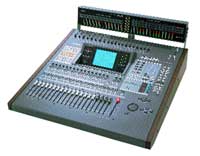 Oven with the continuing boom in digital audio workstations, mixing consoles of all speeds, sizes and configurations are in high demand. Manufacturers continue to find ways to upgrade their consoles to meet the rigors of the post audio community, whether it's all new software releases or completely redesigned boards with higher levels of functionality and user friendliness. It's not surprising - especially given the everything-is-due-yesterday nature of the business - that speed is one of the most important attributes console manufacturers must keep in mind to have a successful product on the market.
Oven with the continuing boom in digital audio workstations, mixing consoles of all speeds, sizes and configurations are in high demand. Manufacturers continue to find ways to upgrade their consoles to meet the rigors of the post audio community, whether it's all new software releases or completely redesigned boards with higher levels of functionality and user friendliness. It's not surprising - especially given the everything-is-due-yesterday nature of the business - that speed is one of the most important attributes console manufacturers must keep in mind to have a successful product on the market.
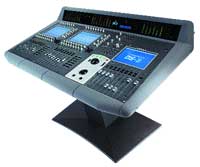 In addition to speed, manufacturers are paying closer attention to bus structure. As Dave Hansen, VP of product marketing at Euphonix, explains, "Being able to route signals in any of the surround formats to tape decks while at the same time being able to monitor the selected format or any other variance of it at the same time is becoming critical." It's especially important, he adds, during those moments where a 5.1 mix is printing but a stereo mix needs to be checked, but stopping the process would destroy the mix. "So, you have to have an ultimate flexibility in bussing and monitors to be able to deal with them at the same time," he says. "That's something that I think separates the big expensive console manufacturers from the less expensive manufacturers."
In addition to speed, manufacturers are paying closer attention to bus structure. As Dave Hansen, VP of product marketing at Euphonix, explains, "Being able to route signals in any of the surround formats to tape decks while at the same time being able to monitor the selected format or any other variance of it at the same time is becoming critical." It's especially important, he adds, during those moments where a 5.1 mix is printing but a stereo mix needs to be checked, but stopping the process would destroy the mix. "So, you have to have an ultimate flexibility in bussing and monitors to be able to deal with them at the same time," he says. "That's something that I think separates the big expensive console manufacturers from the less expensive manufacturers."
That's not to say, however, that only the most expensive consoles are the ones selling today. Indeed, manufacturers of lesser-priced desks are seeing increased sales as the number of boutique studios grows. So perhaps it's no surprise that manufacturers of all market segments are driving to improve their products. Here is what some of top manufacturers reported to Post in our spotlight on mixing consoles.
SSL Avant Plus
- new control processor
- TFT LCD display
Solid State Logic (www.solid-state-logic.com) introduced the Avant Plus digital post & film console and the Aysis Air Plus digital broadcast production console at this year's AES Convention. Sue McDonald, product executive at SSL, reports that the "Plus" upgrades created a new system for both consoles. "It uses the same control surface as the existing Avant console and some of the existing technology in terms of the audio processing," she says, "but it adds a new control processor, a new pool of development software and some other new features as well. The main benefit to our clients is in terms of speed, so a lot of the functionality of the console and its capabilities have been vastly improved. Some functions are now up to 100 times faster than in the previous platform." This new-found speed enables the consoles to handle much larger mixes while being more responsive to the mixing engineer.
On the hardware end of things, McDonald explains that the Avant's display has been changed to a fully integrated TFT LCD display with a new graphics software package. The display also boasts a second external input that can be used for displaying digital audio workstation information. Other hardware changes include advancements in the Avant's fader system. The new INFO faders add a display so users can see such things as grouping information and where the automation is playing with respect to fader level. The faders are also hot-swappable. Software changes push the Avant Plus to higher levels of speed and functionality.
McDonald explains that the new HS control processor is so powerful that currently only 10 percent of its capacity is being used. "Now we're into a stage where we can take that platform and develop further," she says. The Avant Plus now features Premix Masters, a software where multiple six or eight premix channels can be stacked beneath individual premix master faders; SuperGrouper that allows for multiple sets of rotary, switched and fader-driven controls to be freely grouped across the console, including EQ, panning and dynamics; and PanPoint that enables surround panning with a pen and tablet.
As McDonald reports, SSL isn't done upgrading the system. "There's a continual process of ongoing software releases," she says. "There's been a rolling program for some of our other digital projects, but we're a little way off of having details for that."
YAMAHA 02R
- V.2.0 software
- 24-bit recording capability
The Yamaha (www.yamaha.com.jp/product/proaudio/homeenglish/) O2R is one of the most popular consoles in the post market, and with Version 2 software the board adds a new level of functionality. Version 2 adds 24-bit recording capability; surround panning options; Auto Mix (for offline editing); I/O Assign; and touch sense fader editing. The 40-input/eight-bus configuration of the O2R also features individual channel EQ and dynamics processors, effects libraries, scene snapshots and on-board automation. The new software adds to that with more versatile I/O assigning of input patching and slot and aux output selection as well as MIDI remote; MIDI control assign; on-board MS stereo decoding; bus channel pairing; more flexible routing assignment; and fader grouping.
Sony Electronics OXF-R3, DMX-R100
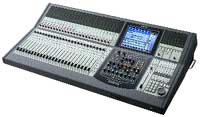 Two of Sony Electronics' (www.sony.com/proaudio) digital audio consoles - the Oxford OXF-R3 and the DMX-R100 - have been revamped. The Oxford OXF-R3 has been streamlined for surround sound capability says Terry Murphy, Sony Electronics' marketing manager, pro audio. "In the past we have done surround sound and we did a fine job. This just totally streamlines the process and really brings it up to where it should be," he says. The Oxford's Version 3.0 upgrade includes a new monitor panel where users can view stereo, LCRS, 5.1 and 7.1 formats. Also, Murphy says, the fold down capabilities and matrix on the Oxford have been improved. "We've added a page called the Fold Down Page so if the user is not satisfied with the default coefficient of how we chose to fold it down, it can be tweaked." Further, the session can also be folded down as a program output. Super Send Groups are another feature in the new Oxford Version 3.0. This allows flexible grouping into mono, stereo, LCRS, 5.1 and 7.1, and each group send can have its own independent fader and joystick that enables realtime 5.1, 7.1, LCRS and stereo mixes.
Two of Sony Electronics' (www.sony.com/proaudio) digital audio consoles - the Oxford OXF-R3 and the DMX-R100 - have been revamped. The Oxford OXF-R3 has been streamlined for surround sound capability says Terry Murphy, Sony Electronics' marketing manager, pro audio. "In the past we have done surround sound and we did a fine job. This just totally streamlines the process and really brings it up to where it should be," he says. The Oxford's Version 3.0 upgrade includes a new monitor panel where users can view stereo, LCRS, 5.1 and 7.1 formats. Also, Murphy says, the fold down capabilities and matrix on the Oxford have been improved. "We've added a page called the Fold Down Page so if the user is not satisfied with the default coefficient of how we chose to fold it down, it can be tweaked." Further, the session can also be folded down as a program output. Super Send Groups are another feature in the new Oxford Version 3.0. This allows flexible grouping into mono, stereo, LCRS, 5.1 and 7.1, and each group send can have its own independent fader and joystick that enables realtime 5.1, 7.1, LCRS and stereo mixes.
Along with the Oxford console software, Sony's DMX-R100 software was upgraded to version 2.0. The console became more flexible with the introduction of the DMBK-R109 MADI expansion card for the R100. Sony product manager Karl Kussmaul explains that the new software enables faster surround sound processing as well as greater recallability of equalizer settings.
Euphonix System 5
- ?lm production panel
- dual joystick panners
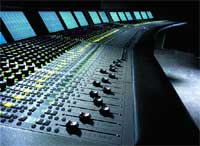 Euphonix's Dave Hansen reports the company is continuing to work on refinements to the System 5 digital console, the R-1 multitrack recorder, the FC-727 digital format converter and a new 2.5 version of the Euphonix (www.euphonix.com) software. "The main thrust has been the film monitoring production panel and the joysticks," Hansen explains. "The dual joystick panner allows panning between any of the speaker formats that you find from stereo all the way up to 7.1 SDDS."
Euphonix's Dave Hansen reports the company is continuing to work on refinements to the System 5 digital console, the R-1 multitrack recorder, the FC-727 digital format converter and a new 2.5 version of the Euphonix (www.euphonix.com) software. "The main thrust has been the film monitoring production panel and the joysticks," Hansen explains. "The dual joystick panner allows panning between any of the speaker formats that you find from stereo all the way up to 7.1 SDDS."
The film production panel, Hansen says, works for clients who are managing mixes from stereo to full surround for longform television and film. "It consists of the film industry standard paddle switches, and these interface with the recorders and the monitor systems so you can manage a large number of tracks and a large number of formats by grouping them to these switches," he reports. "So, you can throw one switch and you can be putting eight channels of stuff into record. That can be just your dialogue section and your next switch is music and the next is effects - so you can manage large groupings of things very simply."
The joystick panner eases the demand of pushing a sound element around the monitor field. "It's much easier with a joystick than with two knobs," Hansen observes. "The joysticks are automated and motorized - it has a motor that drives its X and Y axis, so it can actually playback the move and you can see it as well as hear it. A lot of the other guys are doing it without moving and you can only see the dot on the screen, rather than see the move of the joystick, we do both."
AMS Neve Logic 7
- 48kHz/96kHz capability
- optional eight-band graphic EQ
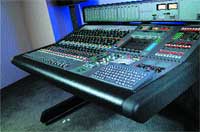 The new Logic 7 console continues the long legacy of AMS Neve (www.ams-neve.com) boards and is the successor to the Logic 2, according to AMS Neve business development manager (post production) Guy Gampell. "It draws on all the experience and everything that was learned operationally from people on the DFCs," he says. The Logic 7 has the same ESP signal processing that was developed for the DFC, so the console can mix 512 signal paths at 48K and 250 signal paths at 96K. Also, Gampell reports, "It's very user friendly; it's probably the most user friendly digital console we've ever come up with, and it's hit the ground running fully featured."
The new Logic 7 console continues the long legacy of AMS Neve (www.ams-neve.com) boards and is the successor to the Logic 2, according to AMS Neve business development manager (post production) Guy Gampell. "It draws on all the experience and everything that was learned operationally from people on the DFCs," he says. The Logic 7 has the same ESP signal processing that was developed for the DFC, so the console can mix 512 signal paths at 48K and 250 signal paths at 96K. Also, Gampell reports, "It's very user friendly; it's probably the most user friendly digital console we've ever come up with, and it's hit the ground running fully featured."
The main features of the Logic 7, Gampell says, have to do with the human interface with the console. "One of the aims of it was that it should be very easy for freelancers to walk up to and learn, which to be honest in some respects DFC isn't," he explains. As an example, Gampell points to the fact that the Logic 7 has strip-by-strip routing buttons instead of relying on menus. "It's done at the top of the channel strip like, dare I say it, an old-fashioned desk," he adds.
On the Logic 7 there's an option of an eight-band automated graphic EQ, as well as the established EQ of the DFC, where each of the EQs are fully sweepable from 20Hz to 20kHz and each of the four bands can be any type of filter. "So, you've got four identically specified multi-functioned equalizers on each channel," Gampell says. "It's a very sophisticated EQ. Any fader can be mono or stereo. It runs on the same automation platform as the DFC and the Neve 88R." The console can also work with all of the past Logic boards and it networks through Starnet.
Fairlight Dream
- 48-track recorder
- flexible control surface
The Fairlight Dream suite of tools, which includes the Satellite editing workstation, the Dream Station and the Dream Console, offers users a flexible integrated production system that can be used independently or in concert with each other. "We wanted to come up with a system that is flexible across the whole series of applications and be able to move audio and automation data from a smallish room using a Dream Station all the way up to a very large room using a Dream Console," explains Andrew Brent, worldwide technical director of Fairlight ESP (www.fairlightesp.com). "It allows you to do things like DVD pre-production as well as final mix on the stems for a feature film. You could do the work on the console and take all the automation and elements down to a station and do the pre-production for the DVD on a much smaller, more cost effective system."
The Dream console, Brent adds, was designed with post applications in mind. "It's been put together to handle surround sound in a much more efficient way than consoles that have come before it," he says. The console has a 48-track digital recorder as part of the element, it can return 192 elements to a mix and it comes in either a five-bucket or three-bucket configuration. The central assignment panel, where EQ settings and dynamics can be altered, can be duplicated throughout the console. "These systems are designed where they could go one or two ways - they have a dedicated strip and you can put all the controls on that strip or you have a call button where you call the central assignment panel," Brent explains. "We can configure the console so that it has one central assignment panel or it has multiple central assignment panels directly above the faders, so the surface itself is quite expandable." Other benefits include built-in plug-ins that are fully networkable with Media Link.
Otari Status and Elite +
Otari (www.otari.com) offers two consoles that are staples in post facilities: the Elite+ and the Status. Both boards are surround capable with the addition of the Otari PicMix outboard system. The Elite+ is the Otari flagship board and it features top-of-the-line mic pre-amps, EQ and dynamics, as well as Eagle Automation that automates faders, switches, joysticks and snapshots. The company's Image Recall System stores input-module settings, and an LED-guided Nulling System enables quick recall. The Status console also boasts Eagle Automation and comes in three frame sizes, either with or without a patchbay. It has 12 record buses, eight aux sends and four-band EQ. Options for the Status include comprehensive dynamics /compressor, limiter and gate - for each input module, PicMix for surround sound monitoring and panning, stereo input modules and a TT Patchbay.
TASCAM DM-24
The TASCAM (www.tascam.com) DM-24 is one of the more affordable small format consoles that is 24-bit, 96kHz compatible and has a 32-channel/eight-bus with six aux sends. There are 16 analog inputs with XLR mic and TRS line inputs on each channel and 24 channels of TDIF interfacing, plus eight channels of ADAT Optical I/O, two stereo AES/EBU and two stereo S/PDIF interfaces. There are also two option slots for additional interface modules or a Cascade module for linking two DM-24s.
The board also has built-in automation that can be run without an external PC and can store eight mixes. Other benefits include a configurable compressor and a four-band parametric EQ on each channel. The DM-24 comes with a 32-bit floating-point processor that ensures 24-bit performance throughout the digital chain.